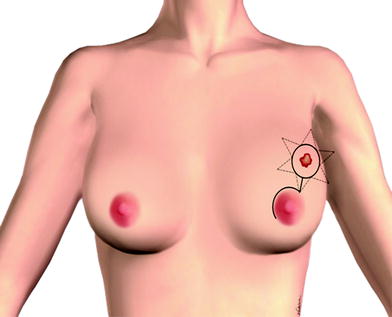Fig. 8.1
Breast Langer’s lines
8.5 The Subunit Principle
On the grounds of the breast subunit principle, two major approaches to reconstruction are described:
1.
Reconstructions with flaps respecting the aesthetic subunits and thus producing good results.
2.
Reconstructions not respecting the aesthetic subunits and thus giving a patch-like appearance to the anterior chest area.
The aesthetic subunits are characterized by the type of the skin, including its hue, texture, and thickness. These characteristics convey a uniform visual impression. The anatomical transitions between the breast and its boundaries, mainly the skin of the chest and the upper abdomen, demarcate clear transitional areas. Differences in the skin hue determine the characterization of the subunits and are crucial for the aesthetics of reconstruction.
Transitions are perceptible between the following locations:
Breast skin and areola
Areola and nipple
Breast skin and sternum skin
Breast skin and upper abdomen skin
Breast skin and lateral chest wall skin
Spear and Davison [11], in a 2003 review covering 10 years, assessed 264 patients who underwent reconstruction with autogenous tissue and concluded that the main breast subunits to be reconstructed and that afforded the best results in terms of appearance and scar camouflage were the areolar–papillary complex and the periareolar area. Once again, they emphasized the importance of taking these structures into account in surgical planning to achieve good results.
8.6 Reconstruction in Partial Mastectomies
The main goal of partial reconstruction is to preserve the cone shape of the breasts with the areolar–papillary complex centered on the breast projection apex. Scars must be linear or oblique and follow the lines of force (Langer’s lines). Whenever possible, it is advisable to place the scars in the lower quadrants, inframammary fold, and periareolar area. The most difficult areas, which result in more visible scars, are the upper medial quadrants, which are not covered by the clothes.
The skin resection should be performed concentrically to the tumor, thus allowing the appropriate orientation of scars toward the better-camouflaged areas of the breasts (Fig. 8.2).


Fig. 8.2
The skin resection should be performed concentrically to the tumor, thus allowing the appropriate orientation of scars toward the better-camouflaged areas of the breasts
8.7 Classification of Aesthetic Results According to the Position of Scars (Sampaio and Fraga)
According to the principles of the position and quality of scars in breast reconstruction, the scars may be classified into five types in decreasing order as a function of the aesthetic results (Fig. 8.3):



Fig. 8.3
Scar types: a type 1–periareolar scar; b type 2—scar on the lower pole; c type 3—scar on the upper lateral quadrant; d type 4—scar on the upper medial quadrant; e type 5—scar crossing over quadrants
1.
Periareolar scar (most favorable)
2.
Scar on the lower pole
3.
Scar on the upper lateral quadrant
4.
Scar on the upper medial quadrant
5.
Scar crossing over quadrants (least favorable)

8.8 Reconstruction in Total Mastectomies
Attention to the breast subunits favors the aesthetic results of reconstruction. Scars on the inframammary fold and lateral wall of the chest have better quality than scars on the medial and upper pole.
The total reconstruction of one breast segment affords better results than the reconstruction of one quadrant because it avoids the patch-like appearance.
Stay updated, free articles. Join our Telegram channel

Full access? Get Clinical Tree








